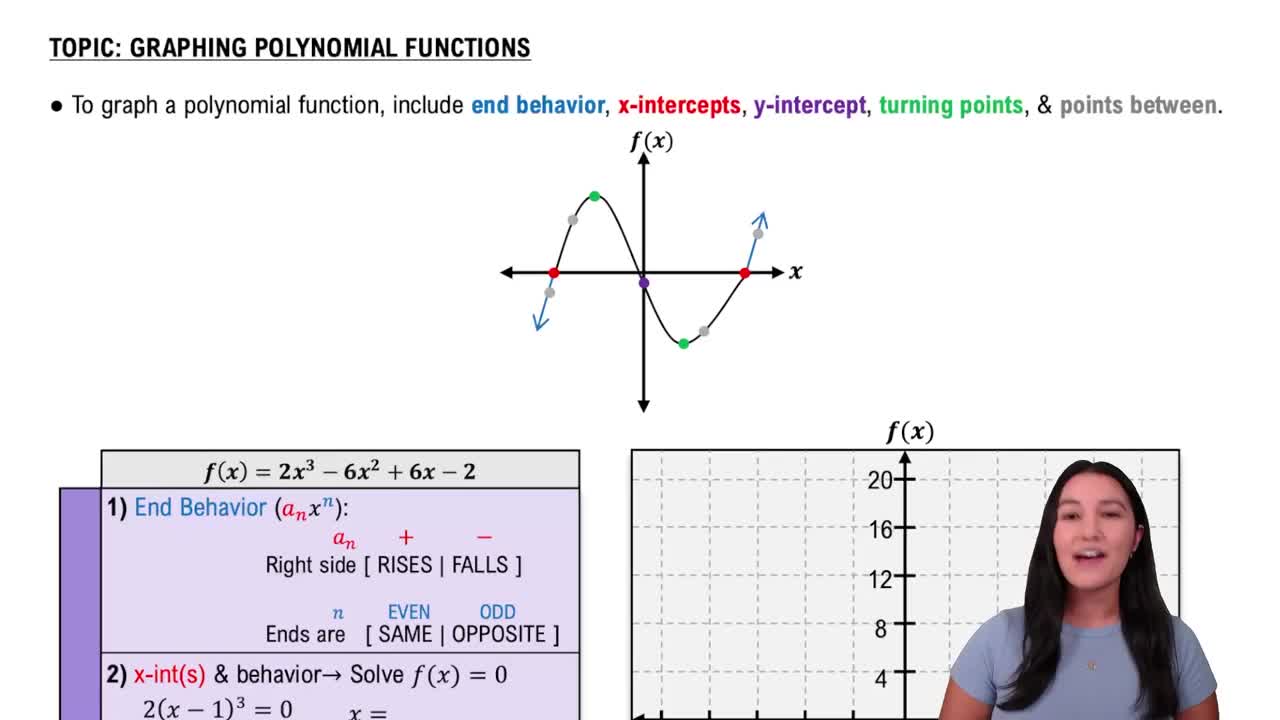Table of contents
- 0. Review of Algebra4h 16m
- 1. Equations & Inequalities3h 18m
- 2. Graphs of Equations43m
- 3. Functions2h 17m
- 4. Polynomial Functions1h 44m
- 5. Rational Functions1h 23m
- 6. Exponential & Logarithmic Functions2h 28m
- 7. Systems of Equations & Matrices4h 6m
- 8. Conic Sections2h 23m
- 9. Sequences, Series, & Induction1h 19m
- 10. Combinatorics & Probability1h 45m
3. Functions
Intro to Functions & Their Graphs
Problem 7c
Textbook Question
To answer each question, refer to the following basic graphs. Which one is the graph of ƒ(x)=∛x? Is there any open interval over which the function is decreasing?
 Verified step by step guidance
Verified step by step guidance1
Step 1: The function ƒ(x)=∛x is the cube root function. The graph of this function starts from negative infinity, passes through the origin (0,0), and extends to positive infinity. It is an increasing function throughout its domain.
Step 2: An increasing function is a function where the value of y (the output) increases as the value of x (the input) increases. In other words, as you move from left to right on the graph, the y-values are always going up.
Step 3: A decreasing function is a function where the value of y (the output) decreases as the value of x (the input) increases. In other words, as you move from left to right on the graph, the y-values are always going down.
Step 4: Since the cube root function is always increasing, there is no open interval over which the function is decreasing.
Step 5: Therefore, the answer to the question 'Is there any open interval over which the function is decreasing?' is no.
Recommended similar problem, with video answer:
 Verified Solution
Verified SolutionThis video solution was recommended by our tutors as helpful for the problem above
Video duration:
3mPlay a video:
Was this helpful?
Key Concepts
Here are the essential concepts you must grasp in order to answer the question correctly.
Graph of the Cube Root Function
The function ƒ(x) = ∛x represents the cube root of x, which is a continuous and increasing function for all real numbers. Its graph passes through the origin (0,0) and has a characteristic shape that flattens out as x approaches both positive and negative infinity. Understanding this graph is essential for identifying its behavior and properties.
Recommended video:

Graphing Polynomial Functions
Increasing and Decreasing Functions
A function is considered increasing on an interval if, for any two points x1 and x2 in that interval, if x1 < x2 then ƒ(x1) < ƒ(x2). Conversely, a function is decreasing if ƒ(x1) > ƒ(x2) for x1 < x2. Analyzing the intervals of increase and decrease helps in understanding the overall behavior of the function.
Recommended video:

Maximum Turning Points of a Polynomial Function
Open Intervals
An open interval (a, b) includes all numbers between a and b but does not include the endpoints a and b themselves. In the context of functions, identifying open intervals where a function is increasing or decreasing is crucial for understanding its behavior over specific ranges. This concept is fundamental in calculus and algebra for analyzing function behavior.
Recommended video:

Interval Notation

 5:2m
5:2mWatch next
Master Relations and Functions with a bite sized video explanation from Nick Kaneko
Start learningRelated Videos
Related Practice






